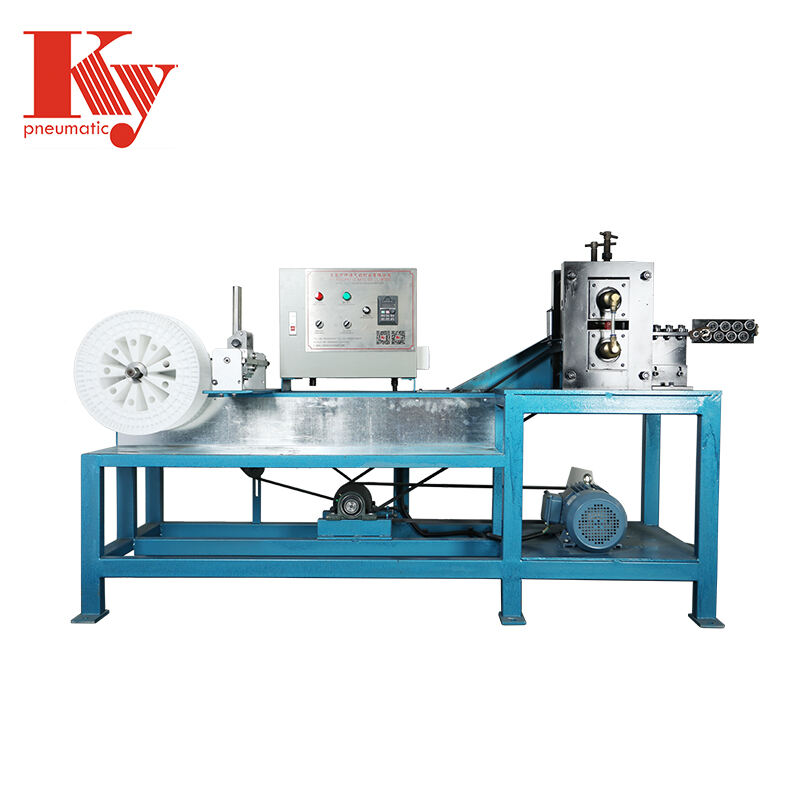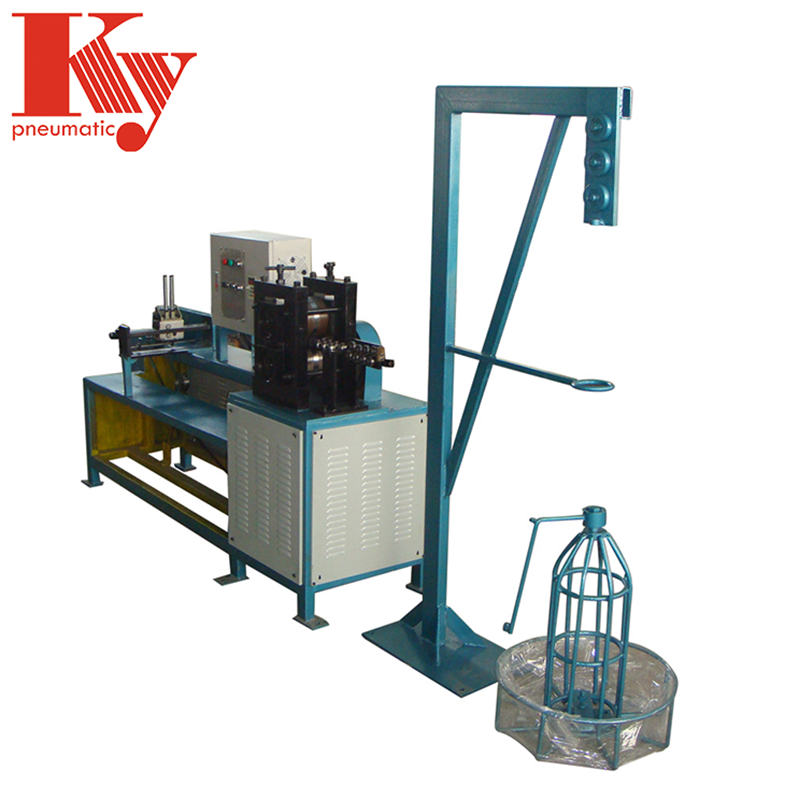How Wire Flattening Machines Work
Core Mechanism of Wire Flattening Machines
The Rolling Process: From Round Wire to Flat Strips
Wire flattening machines rely heavily on the rolling process, where round wires get turned into flat strips. Basically what happens is the wire gets pushed through these big cylindrical rollers that squeeze it until its shape changes from round to flat. The main parts making this work are obviously the rollers themselves plus some special dies that help form and finish the wire according to what specs are needed. Industry data shows pretty clearly that better roller tech has really boosted flat wire production rates. Looking at recent studies, there have been major improvements both in how fast things get made and how consistent the final products turn out. Because of all this progress, wire flattening equipment has become indispensable across many industries including aerospace manufacturing and electronic component fabrication.
Pressure Calibration for Precision Thickness
Getting the pressure right during production makes all the difference when it comes to achieving consistent thickness and uniformity in flat wire products. If pressure settings aren't kept tight under control, we end up with wires that vary in thickness across different sections. Modern wire flattening equipment actually incorporates some pretty sophisticated tech these days. Most machines now come equipped with built-in sensors and computer controls that constantly monitor and adjust pressure levels throughout the manufacturing process. Research from several manufacturers indicates that getting calibration spot on can really boost product quality. When wires are uniformly thick, they perform much better in their final applications. This matters a lot for sectors where measurements need to be exact down to fractions of a millimeter, like in surgical instruments or circuit boards for consumer electronics. A slight variation in thickness could mean the difference between a functioning device and one that fails entirely.
Speed Control Systems for Consistent Output
The way we control speed makes all the difference when it comes to how well wire flattening machines work and how consistent they are. When the wire moves through those rollers at just the right pace, what comes out looks uniform and meets quality standards every time. Most factories use things like variable frequency drives, or VFDs for short, to handle those speed changes without wasting energy. Looking at actual manufacturing examples shows that getting speed right means better production numbers and less wasted material on the floor. Getting this balance right between how fast things go and the quality of the final flat wire product matters a lot. Industries need to hit their targets while still keeping standards high, and proper speed control helps them do exactly that without compromising either side.
Essential Components and Their Functions
High-Strength Alloy Rollers
Strong alloy rollers play a key role in wire flattening processes because they last longer and work better overall. When machines use these special rollers, they experience less wear and tear, so they can keep running smoothly for months at a time without needing parts replaced all the time. The solid build of these rollers maintains even pressure throughout the rolling process, which is really important if we want consistently flat wires every single time. Companies such as KY Pneumatic Nail have started using high strength alloys in their equipment, and this change has made their flattening machines last much longer in practice. We've seen this work well in real world situations too, especially during various aerospace manufacturing projects where reliability matters most.
Water Cooling Systems for Thermal Stability
Water cooling systems are really important for keeping things from getting too hot during wire flattening operations. They basically run coolant through the machinery to soak up all that heat created when wires get rolled and flattened. Good cooling keeps the machine parts safe and makes them last longer. Most people who know about this stuff say that when machines stay at proper temperatures, they tend to work better over time. This matters a lot in factories where production needs to keep going nonstop, especially places making those super precise parts needed for airplanes and spacecraft.
Tension Control Modules
Tension control modules play a key role in keeping wire intact during flattening processes. These systems prevent wires from becoming either too stretched or slack, something that directly affects the final finish quality after flattening. When tension is properly managed, the resulting wire dimensions stay consistent across production runs. Manufacturing reports show that good tension control cuts down on defects like uneven surfaces in the end product. The accuracy these systems provide matters a lot across different sectors, from automotive parts to electrical components, where precise measurements and reliable quality standards are non-negotiable requirements for most manufacturers.
Diverse Industrial Applications
Aerospace Component Manufacturing
In aerospace manufacturing, wire flattening machines are essential tools when it comes to making components that require exact measurements. They help produce things like structural supports, connectors, and electrical paths that must work flawlessly in aircraft construction. The aerospace field needs top quality flat wire because safety regulations leave no room for error. Flat wire actually improves how materials behave under stress, spreading forces more evenly across structures and reducing weak spots that could lead to failures mid-flight. Manufacturers keep pushing for better flat wire solutions as new aircraft designs emerge with increasingly complex requirements for weight reduction while maintaining structural integrity.
Agricultural Wire Mesh Production
Wire flattening machines play a key role in manufacturing agricultural wire mesh that's become essential across modern farms. The process gives wire greater strength and lasts longer, so it works well for all sorts of farm uses from building fences to constructing animal enclosures. Farmers find flat wire mesh stands up better against weather extremes and daily wear and tear, which makes sense when protecting valuable crops or livestock. Many growers have switched to flat wire mesh because it holds up better over time and actually saves money in the long run compared to traditional options. With new farming methods emerging constantly, we're seeing more and more demand for this type of durable mesh solution throughout the agriculture industry.
Electronics and Copper Bar Processing
Wire flattening machines play a vital role when it comes to conductor processing for electronics work. These machines help ensure that copper bars get processed with the right level of precision so they can maintain good electrical conductivity properties. When we talk about flattened copper bars, they're really important for things like electronic circuits because their precise shape allows signals to travel through them efficiently and helps distribute power properly across components. Looking at what's happening in the industry, manufacturers who use these flattened copper bars tend to see real benefits both economically and in terms of product performance. The whole electronics sector is growing fast, which means there's going to be even greater demand for quality flat copper bars moving forward. Companies that want to stay ahead technologically and keep their products competitive will need access to reliable sources of properly flattened copper materials.
Premium Wire Flattening Equipment
KY Pneumatic Nail Wire Flattening Machine
What sets the KY Pneumatic Nail Wire Flattening Machine apart are its solid specs and real improvements in productivity. Built with a strong alloy rim, it can flatten different types of high strength iron wires, even tough ones like spring steel, down to whatever diameter customers need. The design stays pretty straightforward yet stable enough for smooth operation day after day, plus parts are accessible when maintenance becomes necessary. A water cooling system helps maintain precise flattening results too, so operators can run at speeds reaching around 300 meters per minute without losing quality. Field reports show workers appreciate how dependable this machine remains even during long shifts or under tough conditions where other equipment might struggle.
Fully Automatic Industrial Galvanized Iron Wire Flattening Machine
The fully automatic industrial galvanized iron wire flattening machine represents a major step forward in wire processing tech, cutting down on labor expenses while boosting productivity across the board. What sets this equipment apart are those special alloy cone wheels that last about ten times longer than regular ones, which means fewer replacements and smoother operation over time. Most commonly used for working with strong iron wires, these machines handle all sorts of specs needed for different industries from galvanized iron to copper wire manufacturing. With so much automation built in, there's just not as much hands-on work required anymore, leading to better precision and faster output rates. Factory reports show some plants doubling their production capacity after switching to these systems, making them essential gear for any serious wire processing operation today.
Optimizing Performance and Longevity
Routine Maintenance Protocols
Keeping wire flattening machines running smoothly requires good maintenance habits that actually extend their working life. When doing regular checks, workers need to clean out debris, look closely at parts that show signs of wear, and double check if everything is properly calibrated. Most equipment makers suggest sticking to a monthly maintenance schedule as a way to keep things running right and stop unexpected breakdowns from happening. Industry experience shows pretty clearly that machines maintained according to schedule tend to perform better over time. Beyond just preventing problems, regular upkeep makes financial sense too since fixing major issues down the road often costs far more than simple routine checks would have.
Lubrication Best Practices
Keeping wire flattening machines properly lubricated helps cut down on wear and makes them run better overall. Choosing the right lubricant matters a lot because various parts inside these machines need different kinds of protection to work correctly. For most applications, thick oils or synthetic grease tend to be the go-to options for bearings and moving components since they stick around longer and provide better coverage. Maintenance manuals from manufacturers often highlight how regular lubrication cuts machine downtime by up to 40% in some cases, which means fewer surprises when production lines come to a halt. Smart shops develop routine maintenance schedules for lubrication tasks not just to keep things running smoothly day to day, but also to stretch out the lifespan of expensive equipment before needing replacement.
Troubleshooting Common Operational Issues
Wire flattening machines often run into trouble that affects their ability to keep producing consistently. The main headaches tend to be inconsistent wire thickness, annoying vibrations during operation, and components getting stuck together. When this happens, maintenance staff need to look at whether everything is aligned correctly, make sure there's enough tension throughout the system, and give those moving parts a good cleaning now and then. Manufacturers who actually follow through with these basic fixes see real results. Some plants report cutting down on machine downtime by about 30% after implementing regular maintenance routines. Getting ahead of these problems before they escalate means better product quality across the board and fewer production interruptions that cost money and time.
 EN
EN
 AR
AR
 BG
BG
 CS
CS
 FI
FI
 FR
FR
 DE
DE
 EL
EL
 HI
HI
 IT
IT
 JA
JA
 KO
KO
 PL
PL
 PT
PT
 RU
RU
 ES
ES
 TL
TL
 ID
ID
 LT
LT
 SR
SR
 UK
UK
 VI
VI
 SQ
SQ
 GL
GL
 HU
HU
 MT
MT
 TH
TH
 TR
TR
 AF
AF
 MS
MS
 AZ
AZ
 KA
KA
 BN
BN
 LO
LO
 LA
LA
 MI
MI
 MN
MN
 NE
NE
 KK
KK
 UZ
UZ



